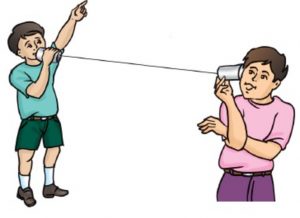Question 1 What does the working of a toy telephone tell us about sound?
Question 2 Name one solid, liquid and a gas through which sound can travel?
Question 3 Why sound cannot travel through vacuum?
Question 4 Define the term medium?
Question 5 How can you show that sound cannot travel vacuum?
Question 6 Why sound cannot be heard on the moon?
Question 7 How do astronauts talk to each other on moon and why?
Question 8 Describe an activity to show that sound travels through solids?
Question 9 Describe an activity to show that sound travels through liquid?
Question 10 Describe an activity to show that sound travels through gases?
Medium
The substance through which sound travels is called medium
The medium can be solid, a liquid or gas.
Sound needs a material medium like solid, liquid or gas to travel and be heard because the molecules of solid, liquid and gases carry sound waves from one place to another.
Sound cannot travel through vacuum or empty space because vacuum has no molecules which can vibrate and carry sound waves.
Activity
(1) Let us press our ear on to one side of a wooden bench and ask a friend to tap or scratch the other end of the bench lightly. We will hear the sound of tapping or scratching through the wooden bench quiet loudly. This means that sound can travel through wood, which is a solid.
(2) Take to open tin cans, each having a small hole at the centre of its bottom. Also take about 20 metres long thick thread. Pass one end of the thread into the hole of one tin-can and hold it Inside the can by tying it to a pin. Similarly, pass the other end of thread into the hole of second tin can and tie it to another pin. The two tin cans connected by the thread are now held by two children and taken as far as possible so that the thread gets stretched tightly.
Now if one child speaks into one tin can, he can be heard by the child at the other end who puts his ear to the other tin can. In this case of toy telephone, sound made by the child by speaking travels through the thread, which is a solid substance.
(3) Place a squeaking toy or sound making toy in a polythene bag and immerse it in a bucket full of water. If we put our ear to the side of this bucket and press the toy, we can hear the sound of squeaking toys clearly. The sound of squeaking toy comes to ear through water contained in the bucket. This shows that sound can travel through water, which is a liquid.
Dolphins and whales which live in the sea can communicate or talk with one another underwater because sound travels through sea water which is a liquid.
(4) When the telephone bell rings in our home, we can hear its sound even from a distance. The sound of ringing telephone bell travels to us through the air in the room, which is a gas.
When we talk to a person standing near us, then the sound of our talks travels to the other person through the air around us. The sounds of radio, television, motor cars, buses, trains, aeroplanes and chirping of birds, all travel through the air and reach our ears.
Sound cannot Travel through Vacuum
(1) A ringing electric bell is placed inside an air tight glass jar containing air. We can hear the sound of ringing bell clearly. When air is present in the glass jar, sound can travel through it and reach our ears.
(2) The glass jar containing ringing bell is placed over the plate of a vacuum pump. Air is gradually removed from the glass jar by switching on the vacuum pump. As more and more is removed from the glass jar, the sound of ringing bell becomes fainter and fainter. And when all the air is removed from the glass jar, no sound can be heard at all.
(3) When vacuum is created in the glass jar, then the sound of ringing bell placed inside it cannot be heard. This shows that sound cannot travel through vacuum.
(4) If air is now put back into glass jar, the sound of ringing bell can be heard again. When clapper hits the bell, the bell vibrates. The vibrating bell makes the nearby molecules to vibrate back and forth. These vibrating air molecules make the next layer of air molecules to vibrate and so on.
Ultimately all the air molecules around the ringing bell starts vibrating back and forth. When these vibrating air molecules fall on our ears, we can hear the sound of ringing bell. There is no air between the ringing bell and the ear, then the vibration of the ringing bell cannot reach our ears and hence we cannot hear the sound of ringing bell. When there is vacuum in glass jar, there are no air molecules to to carry sound vibration.
The Case of Moon
It is all vacuum on the surface of moon. Sound cannot be heard on the surface of moon because there is no air on the moon to carry the sound waves. If an astronaut talks to another astronaut on the moon, he would see the lips moving but no sound will be heard at all. This is because sound cannot travel through the vacuum which exist on the surface of moon. There is no air in outer space to carry sound waves. It is all vacuum in outer space due to which sound cannot be heard in outer space. The astronauts who land on moon talk to each other through wireless sets using radio waves. This is because radio waves can travel even through vacuum.



Mam i have a doubt in sound chapter that is the sound travells through water
Sound waves can travel through any substance, including gases (air), liquids (water), and solids.
This article states about travel of sound . This tells sound needs medium propagation. Thanks for this amazing and interesting write . I loved it very much. Great blog indeed, will visit again future to read more!!